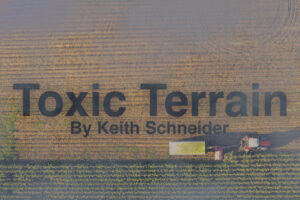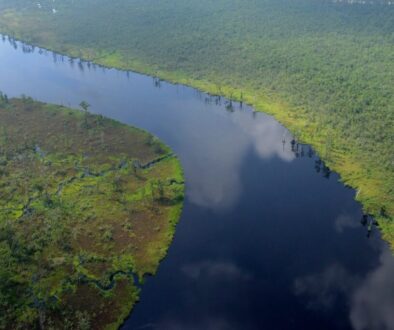Regulators battle Oregon and Washington farmers over limits to farm pollution
 SUNNYSIDE, Washington – Waters from the snowpack of the Cascade Mountains support orchards, vineyards and dairies here in the Yakima Valley of eastern Washington State, boosting a flourishing farm economy and helping to stock store grocery shelves nationwide.
SUNNYSIDE, Washington – Waters from the snowpack of the Cascade Mountains support orchards, vineyards and dairies here in the Yakima Valley of eastern Washington State, boosting a flourishing farm economy and helping to stock store grocery shelves nationwide.
But as the waters flow, so do a host of dangerous farm pollutants, contaminating drinking water wells in the valley and through the adjacent Lower Umatilla Basin across the state line in Oregon.
Regulators and citizen groups have been pressing crop and livestock producers for years to document and rein in the pollution, tightening restrictions on some of the nation’s largest dairies, and bringing litigation against several seen out of compliance.
The actions put both Washington and Oregon among a growing number of US states leading a controversial national campaign to make agriculture more accountable for its mammoth wastes.
“There is a lot of new energy around this problem,” said Salini Sasidharan, assistant professor of groundwater management at Oregon State University. “A lot of investment is being made. There’s momentum here to make a real difference.”
But progress is slow and results are mixed. And farmers are fighting back, saying that they’re doing their best to balance environmental protection and business needs, and the crackdown on their business threatens not just their livelihoods, but also potentially the abundance of the country’s food supply.
Unsafe drinking water
Research has found as many as one in five domestic drinking water wells in Yakima Valley have been contaminated by nitrates above the 10 parts per million federal safety limit. High nitrate concentrations in drinking water have been linked to health problems for babies and are suspected carcinogens.
The concerns date back many years. A 2010 groundwater quality assessment for Washington state regulators reported that over 2,000 residents were drinking water from contaminated wells.
The US Environmental Protection Agency (EPA) traced the contamination to Yakima’s biggest dairies and in 2013 the agency and four dairies negotiated a formal consent order to provide affected homeowners clean drinking water, fix leaking manure storage lagoons, drill monitoring wells and take samples regularly, and control how much manure they applied to fields
In late June, the EPA filed a lawsuit against three of those dairies, however, alleging manure from the combined count of more than 30,000 dairy cows continues to contaminate area drinking water with harmful nitrates and seeking a court order to require compliance with the agency’s order. The dairies have “failed to abate the imminent and substantial endangerment,” required of them in the 2013 consent order, the agency alleges. Manure lagoons that dairies previously agreed to repair have still not been properly lined or they’ve abandoned, the EPA alleges.
The dairy defendants asked the judge in the case to deny the EPA’s request for a preliminary injunction, arguing that there are “major holes” in the EPA’s case, and that the government has not properly presented evidence backing its claims. But the judge ruled against the dairies, granting the preliminary injunction on Dec. 17.

The court order came after the EPA told the court last month that it is seeing “alarming trends” in nitrate contamination in the area around the dairies and that absent an injunction, nitrate contamination from the dairies will “continue to cause or contribute to the endangerment of human health.” The EPA said the dairies’ groundwater monitoring data shows “several nitrate hot spots” where nitrate levels in groundwater persist well above allowable levels. Several wells have shown increasing nitrate levels since 2022, the EPA said in the November court filing. The government has been mailing test packets to hundreds of homes in the area this year to test their water and is working to provide residents with alternative water supplies, the EPA said in the court filing.
The EPA also has directed the states of Oregon and Washington to more strictly protect residents of the Lower Umatilla Basin and the Yakima Valley from contaminated water.
The dairy operators and their attorneys did not respond to requests for comment but in responses filed in court, the dairy operators say the EPA’s actions are unwarranted and claim to be victims of a legal “ambush” by the agency.
Across the Columbia River in the Lower Umatilla Basin of Oregon, the story of contamination has been much the same. In 2020, several health advocacy groups petitioned the EPA for emergency action, arguing that the state’s own data “demonstrate that nitrate concentrations in public water systems and underground sources of drinking water have routinely exceeded both federal and state drinking water standards, putting the health of area residents at serious risk.”
“We’ve seen 70 parts per million nitrates in groundwater around here,” said Kaleb Lay, director of policy and research for Oregon Rural Action, a grassroots organizing and advocacy group. “We’ve tested around 1,800 drinking water wells in the basin. In some areas two-thirds are contaminated above the safe level.”
Both Oregon and Washington state regulators have been more aggressively regulating how commercial fertilizer and manure are stored and spread.
Oregon’s Nitrate Reduction Plan, released to the public in September, is specifically meant to commit four state departments to collaborate to reduce nutrient pollution from industrial dairies and big irrigated crop farms in the Lower Umatilla Basin.
In June 2023, the Oregon Legislature passed the strictest statute in the nation to discourage the development of new and the expansion of existing large dairies and other industrial-scale livestock operations in the Umatilla Basin. The new law does so by controlling how much water livestock operations can use, and gives local governments authority to keep big animal feeding operations far from residential areas.
“This is the unavoidable path that the livestock industry has put itself on,” said Tyler Lobdell, staff attorney for Food & Water Watch, a national environmental law and policy group active in regulating livestock wastes in the Pacific Northwest. “Their success at remaining largely unregulated is leading to, frankly, a public health crisis in many places around the country. That just cannot stand in a society like ours.”
Farmers on the defensive
The aggressive oversight puts the agriculture sectors in both states on the defensive. Farmers say they are not responsible for all of the contamination. They argue that other sources could be septic systems and soil saturated by wastes left by long-shuttered industries.
And they say that they are not being given enough credit for actions they’re taking to try to limit the pollution.
Jason Sheehan, who with his wife Karen milks 3000 cows and farms 2,000 acres close to this city of 16,000 residents, said he conducts rigorous soil sampling to determine his nutrient needs. He has drilled monitoring wells to track any evidence of nutrient draining from his operation. He uses moisture probes in his fields to conserve water in irrigation, and cultivates to limit erosion. He has also served since 2010 on a committee of Yakima Valley citizens and local and state government authorities charged with recommending steps to limit pollution.
“There are more and more farms here that are doing these things,” said Sheehan in an interview. “If anybody’s changed the most in this valley in the way they operate, it’s the dairy farmers.
Other farmers echo Sheehan’s frustration and one state farm group – Save Family Farming (SFF) – argues that they are victims of a “war on farming” based on false accusations and fraudulent research.
“The dairy farmers targeted by the EPA have made every good-faith effort to comply with the consent order required by the District Court,” according to a statement issued after the suit was filed by SFF. “They cooperated with the EPA enforcement despite facing relentless bureaucratic harassment.”
The group says the EPA knows that high nitrate levels existed in the groundwater near where the dairies operate before the farms even existed.
The Washington State Dairy Federation attempted to flip the tables on the EPA, suing the agency in 2020, arguing the dairies were fraudulently induced to agree to the 2013 consent order and challenging the validity of the EPA’s data, calling it “shoddy science”. A federal appeals court dismissed the lawsuit in 2021, however.
Two of the four dairies that signed consent orders in 2013 have gone out of business; the most recent closed in October.
“If the EPA’s unjustifiable and unprovoked actions against these larger dairy farms were applied to others, none could survive,” SFF said.
Seeking a breakthrough
As part of the effort to find a solution to the pollution problem, state regulators in Washington and Oregon have declared the contaminated regions of their states to be “groundwater management areas”, overseen by committees of residents and government authorities appointed by the states.
Millions of dollars have been spent since the early 1990s to identify sources of contamination and related environmental and human health consequences. Residents were provided water samplings services and supplies of bottled water at no cost.
State regulators have also worked to compel crop and livestock producers to embrace voluntary nutrient management practices. Most are financed by “conservation” programs administered by the US Department of Agriculture.
But research has shown that these voluntary measures, which include planting cover crops, reducing fertilizer and manure applications, developing buffer strips to protect streams, and building artificial wetlands, are not effective in stemming the tide of contaminants.

“Our state Department of Ecology had not been as aggressive as you’d like it to be,” said Jean Mendoza, a leader of the environmental group Friends of Toppenish Creek, and a member of the committee responding to Yakima Valley contamination. “It seemed they provided a shield for the dairy industry to give Big Ag a pass.”
The same could be said for almost every other region of the country that developed serious farm-related water contamination and tried the same strategy.
Led by the EPA and various states, similar citizen-government committees embraced voluntary practices to solve fertilizer and manure runoff that are polluting Lake Erie, Lake Champlain, the Mississippi River, Lake Okeechobee, the Gulf of Mexico and other iconic waters. The result, just as it is in the Pacific Northwest, is an expensive repository of national negligence.
Officials and citizen leaders here say they are determined to develop a breakthrough model of change.
“Nitrate contamination is a slow moving disaster,” added Kyrre Flege, a nutrient management specialist at the Washington State Department of Agriculture. “Nitrates in groundwater. It takes a long time for this stuff to move through the system. That’s why we measure success on the improvements we can make today that will make a difference over time.”
Other states are similarly cracking down on large farms for pollution problems. In June, Wisconsin state officials issued a $209,000 fine against one large farm for operating for eight years without a permit. The year before, big feeding operation, also in Wisconsin, paid the state nearly $600,000 to settle violations connected to spreading manure and chicken litter illegally.
Last July, Michigan won a big victory against the state Farm Bureau when the Michigan Supreme Court ruled state regulators had full authority to “take all necessary steps” to protect waterways from livestock and poultry pollution.
Earlier this year, the Ohio Department of Agriculture and the state Environmental Protection Agency investigated and fined cattle feeding operations owned by Amish farmers for mismanaging manure and polluting area streams.
Last year, the EPA ordered Minnesota to protect citizens in nine southeast counties from drinking water fouled by fertilizer and manure. Also in 2023, the agency started a major study of livestock pollution; formed an oversight committee of scientists, advocates, and industry representatives; and began a scientific review of the 10 ppm safety limit for nitrates in drinking water.
(This report, co-published with Circle of Blue, is part of an ongoing series looking at how changing agricultural policies are affecting environmental health. Keith Schneider, a former New York Times national correspondent, is senior editor for Circle of Blue. He has reported on the contest for energy, food, and water in the era of climate change from six continents. )
 EWG
EWG


